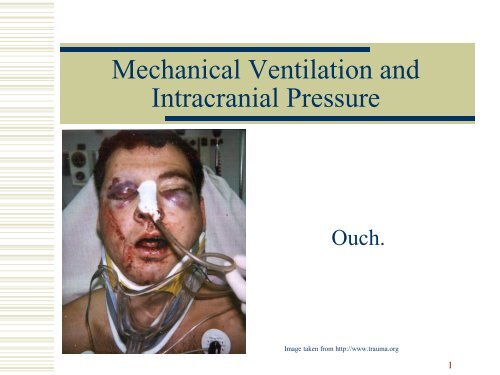Mechanical Ventilation and Intracranial Pressure
Mechanical Ventilation and Intracranial Pressure
Mechanical Ventilation and Intracranial Pressure
You also want an ePaper? Increase the reach of your titles
YUMPU automatically turns print PDFs into web optimized ePapers that Google loves.
Objectives• Implications for Respiratory Therapist• Intubation techniques• Ventilator strategies3
ICP – What is it?• ICP st<strong>and</strong>s for IntraCranial <strong>Pressure</strong>• This is the pressure of the brain, Cerebrospinalfluid (CSF), <strong>and</strong> the brain’s blood supply withinthe intracranial space. 1• Since The Skull is basically a closed system, anincrease in volume will produce an increase inpressure.4
Elevated ICP = DangerAnimated GIF taken from http://www.artie.com5
Other Problems• Elevated ICP can also affect the perfusion ofthe brain• Cerebral Perfusion <strong>Pressure</strong> (CPP) ismeasured by taking the Mean Arterial<strong>Pressure</strong> (MAP) <strong>and</strong> subtracting <strong>Intracranial</strong><strong>Pressure</strong> (ICP)6
What does this mean?• This shows that if the ICP goes up… <strong>and</strong>MAP stays constant… then the CPPdecreases.• This means the patient is not getting as muchblood flow to the brain.7
Poor Outcomes• Having an elevated ICP is one of the mostdamaging aspects of neurological trauma,<strong>and</strong> is directly related to poor prognosis. 28
Normal Values• A normal ICP in an adult ranges from 0-15mmHg 2• An ICP cannot surpass 40 without causingharm. 3• Even values between 25-30 are consideredfatal if they are prolonged. 2• Adam Williams TBI Initiative tx ICP > 20mmHg9
Causes?• An elevated ICP can be caused by many differentetiologies.• Traumatic Brain Injuries• Lyme Disease• Hydrocephalus• Brain Tumor• Severe Hypertension• Venous Sinus Thrombosis• Restricting Jugular Venous flow (i.e. C-collars)• Etc.10
Monitoring• There are 4 main types of devices formonitoring ICP 4Intraventricular CathetersFiber optic MonitorsSubarachnoid BoltsEpidural Monitors11
Intraventricular Catheters 4• Most widely used devices – Most Accurate• A catheter is actually placed inside one of theventricles (a fluid filled cavity in the brainwhere CSF is produced)• Allows treatment <strong>and</strong> monitoringsimultaneously• Can be used to take out excess CSF, therebydecreasing ICP12
Fiber optic Monitors 4• Relatively new technology• A fiber-optic probe is inserted• Into the Brain• Ventricles• Subdural space• The probe contains a transducer on the tipthat measures pressure13
Subarachnoid Bolts 4• These consist of an actual metal “bolt” that isinserted into the skull so that the tip is restingin the subarachnoid space• Easy to install (hey… it’s what they said!)• Limited accuracyImage taken from http://library.ucf.edu/Frankenstein/14
Epidural Monitors 4• Recording devices that are placed into theepidural space• This is a potential space that is locatedbetween the inner surface of the skull <strong>and</strong> thedura matter15
Problems• Main problem is Ischemia due to a decreased CPP –self perpetuating cycle• The body’s response to a decreased CPP is to raise bloodpressure <strong>and</strong> dilate blood vessels in the brain• This increases cerebral blood volume• This increases ICP• This decreases CPP• This causes normal body response• This increases cerebral blood volume• This increases ICP• This decreases CPPAnimated GIF taken from http://www.artie.com• ETC!16
Why does this affect RT?• There are several aspects that RespiratoryTherapists need to be aware of when caringfor a patient that either has, or probably has,an elevated ICP17
Intubation• During normal laryngeal intubation, thenormal body’s reaction is to get agitated• This causes hypertension• This causes an elevated ICP• Therefore adequate pre-medication forintubation is essential 518
Intubation• Preferred method:• Pre-oxygenation• Rapid Sequence Intubation (RSI)• Lidocaine?• Not supported in r<strong>and</strong>om clinical trials• But is recommended to suppress the autonomicresponse from laryngeal stimulation 519
RSI• Rapid Sequence Intubation involvesadministration of a sedative <strong>and</strong> a paralyticbefore intubation• Sedatives used: 6• Sodium thiopental• Propofol• Etomidate20
RSI• Paralytics used: 6• Rocuronium• Succinylcholine• A recent study looked at using midazolamduring RSI• Found an increase in RSI-associatedhypotension 721
Sedation• Agitation increases ICP, therefore it isimportant to keep the patient well sedated.22
Sedation• Why is it important to RT if the patient isfully sedated?• Low ventilatory drive• Must be sure to provide safeguards to ensureadequate minute ventilation23
Ventilatory Strategies• One of the most important treatments forhigh ICP is to control the ABGs• This is because hypoxemia <strong>and</strong> hypercapnia cancause the cerebral blood vessels to dilate <strong>and</strong>raise ICP even more 8• Hypoxemia can also lead to a lactic acidosis,lowering pH <strong>and</strong> causing even more vasodilatoryeffects 224
Ventilatory Strategies• Hyperventilating a patient down to a state ofhypocapnia will do the opposite ofhypercapnia – it will vasoconstrict thevessels in the brain.• BUT……Image taken from http://www.trentu.ca/careers/students/selfassess.html25
Ventilatory Strategies• This limits blood flow to an alreadycompromised-brain.• Also, the brain adjusts to the new level ofCO 2 after 48-72 hrs• Meaning vessels could rapidly dilate if CO 2 wereto return to normal too quickly 926
Ventilatory Strategies• This strategy is used now if there are signs ofbrain herniation, because the herniationmight make it worthwhile to constrict bloodvessels.• If this strategy is used, be sure to go back tonormocarbia GRADUALLY27
Adam Williams TBI Initiative 10• <strong>Ventilation</strong> goals for first 24 hours• pH 7.36 – 7.48• PaCO 2 /End Tidal 35-45 mmHg• P brain tissue O 2 > 20 mmHg or• SpO 2 100%• ICP < 20 mmHg28
Ventilatory Strategies• What about PEEP?• Not unless explicitly needed for oxygenation(Adam Williams Initiative calls for 5 cmH 2 O PEEP initially) 10• PEEP can also increase ICP• Be especially sure to have HOB up if usingPEEP29
References1) Tolias C <strong>and</strong> Sgouros S. 2003. "Initial Evaluation <strong>and</strong> Management of CNS Injury."Emedicine.com.2) Orl<strong>and</strong>o Regional Healthcare, Education <strong>and</strong> Development. 2004. "Overview of AdultTraumatic Brain Injuries."3) Dawodu S. 2004. "Traumatic Brain Injury: Definition, Epidemiology,Pathophysiology" Emedicine.com.4) Columbia University College of Physicians <strong>and</strong> Surgeons, Department of Neurology.2004 “<strong>Intracranial</strong> <strong>Pressure</strong> Monitoring.”5) Robinson N, Clancy M. In patients with head injury undergoing rapid sequenceintubation, does pretreatment with intravenous lignocaine/lidocaine lead to animproved neurological outcome? A review of the literature. Emerg Med) 2001; 18:453-45730
References6) Johansson M, Cesarini KG, Contant CF, Persson L, Enblad P. Changes inintervention <strong>and</strong> outcome in elderly patients with subarachnoid hemorrhage. Stroke2001; 32: 2845-29497) Davis DP, Kimbro TA, Vilke GM. The use of midazolam for prehospital rapidsequenceintubation may be associated with a dose-related increase in hypotension.Prehosp Emerg Care 2001; 5: 163-1688) Su F <strong>and</strong> Huh J. 2005. "Neurointensive Care for Traumatic Brain Injury inChildren." Emedicine.com9) Shepherd S. 2004. "Head Trauma." Emedicine.com.10) Bader MK, Littlejohns L, <strong>and</strong> March K. “Brain Tissue Oxygen Monitoring inServere Brain Injury, II: Implications for Critical Care Teams <strong>and</strong> Case Study”.Critical Care Nurse. 2003;23(4):29-44.31





